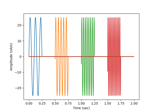mne.simulation.simulate_raw¶
-
mne.simulation.simulate_raw(info, stc=None, trans=None, src=None, bem=None, head_pos=None, mindist=1.0, interp='cos2', n_jobs=1, use_cps=True, forward=None, first_samp=0, max_iter=10000, verbose=None)[source]¶ Simulate raw data.
Head movements can optionally be simulated using the
head_posparameter.- Parameters
- infoinstance of
Info The channel information to use for simulation.
Changed in version 0.18: Support for
mne.Info.- stciterable |
SourceEstimate The source estimates to use to simulate data. Each must have the same sample rate as the raw data, and the vertices of all stcs in the iterable must match. Each entry in the iterable can also be a tuple of
(SourceEstimate, ndarray)to allow specifying the stim channel (e.g., STI001) data accompany the source estimate. See Notes for details.Changed in version 0.18: Support for tuple, and iterable of tuple or SourceEstimate.
- trans
dict|str|None Either a transformation filename (usually made using mne_analyze) or an info dict (usually opened using read_trans()). If string, an ending of
.fifor.fif.gzwill be assumed to be in FIF format, any other ending will be assumed to be a text file with a 4x4 transformation matrix (like the--transMNE-C option). If trans is None, an identity transform will be used.- src
str| instance ofSourceSpaces|None Source space corresponding to the stc. If string, should be a source space filename. Can also be an instance of loaded or generated SourceSpaces. Can be None if
forwardis provided.- bem
str|dict|None BEM solution corresponding to the stc. If string, should be a BEM solution filename (e.g., “sample-5120-5120-5120-bem-sol.fif”). Can be None if
forwardis provided.- head_pos
None|str|dict|tuple|array Name of the position estimates file. Should be in the format of the files produced by MaxFilter. If dict, keys should be the time points and entries should be 4x4
dev_head_tmatrices. If None, the original head position (frominfo['dev_head_t']) will be used. If tuple, should have the same format as data returned byhead_pos_to_trans_rot_t. If array, should be of the form returned bymne.chpi.read_head_pos(). See for example [1].- mindist
float Minimum distance between sources and the inner skull boundary to use during forward calculation.
- interp
str Either ‘hann’, ‘cos2’ (default), ‘linear’, or ‘zero’, the type of forward-solution interpolation to use between forward solutions at different head positions.
- n_jobs
int The number of jobs to run in parallel (default 1). Requires the joblib package.
- use_cpsbool
Whether to use cortical patch statistics to define normal orientations for surfaces (default True).
- forwardinstance of
Forward|None The forward operator to use. If None (default) it will be computed using
bem,trans, andsrc. If not None,bem,trans, andsrcare ignored.New in version 0.17.
- first_samp
int The first_samp property in the output Raw instance.
New in version 0.18.
- max_iter
int The maximum number of STC iterations to allow. This is a sanity parameter to prevent accidental blowups.
New in version 0.18.
- verbosebool,
str,int, orNone If not None, override default verbose level (see
mne.verbose()and Logging documentation for more). If used, it should be passed as a keyword-argument only.
- infoinstance of
- Returns
- rawinstance of
Raw The simulated raw file.
- rawinstance of
See also
Notes
Stim channel encoding
By default, the stimulus channel will have the head position number (starting at 1) stored in the trigger channel (if available) at the t=0 point in each repetition of the
stc. Ifstcis a tuple of(SourceEstimate, ndarray)the array values will be placed in the stim channel aligned with themne.SourceEstimate.Data simulation
In the most advanced case where
stcis an iterable of tuples the output will be concatenated in time as:Data alignment and stim channel encoding¶ Channel
Data
M/EEG
fwd @ stc[0][0].datafwd @ stc[1][0].data...STIM
stc[0][1]stc[1][1]...time →
New in version 0.10.0.
References
- 1
Larson E, Taulu S (2017). “The Importance of Properly Compensating for Head Movements During MEG Acquisition Across Different Age Groups.” Brain Topogr 30:172–181



